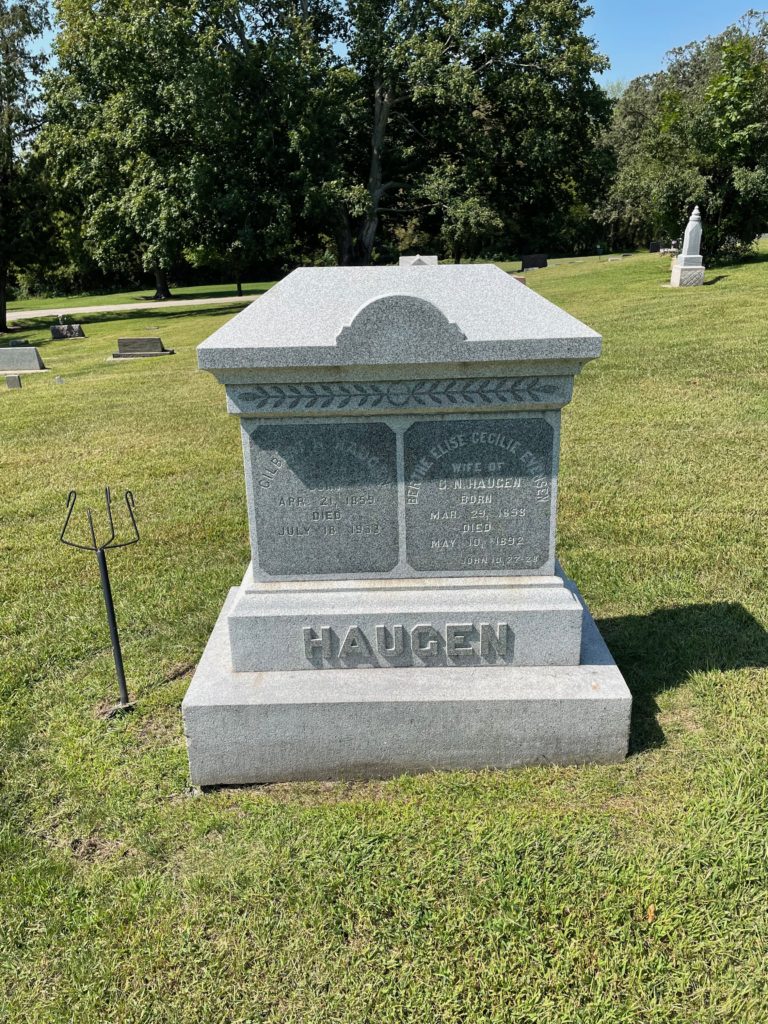Erik Visits an American Grave, Part 1,089
This is the grave of Gilbert Haugen.

Born outside of Orfordville, Wisconsin in 1859, he attended the local schools and then in 1873, the family moved to Decorah, Iowa. He attended a couple of small and now extinct colleges in Iowa and Wisconsin and eventually became a local banker, settling in Northwood, Iowa in 1886. He was good at this and became pretty wealthy. By the time of his death, he owned 20 different farms and was the richest man in the history of Worth County.
Of course, to the extent Haugen is remembered today, it is not because he was a local banker. Every nineteenth century town had those. It’s that he was elected to Congress in 1899 and served there for a very long time. He started his political career with two terms in the Iowa statehouse as a representative before he went to Washington. He would serve 17 terms in Congress.
As a member of Congress, he’s remembered for a couple of things. First, he was part of the minority that voted against the U.S. joining World War I. Given that he represented a lot of German-Americans, this isn’t per se that surprising but it was quite a risky move, especially given the overwhelming anti-German sentiment and widespread violations of civil rights that war opponents would have to burden.
Second, Haugen was known for his commitment to a farm bill that would help farmers. He was chairman of the House Agriculture Committee beginning in 1919 and so had the power to move legislation on this front forward. Such bills were seen as quite controversial. After all, this was still the era of the FREE MARKET and all the fetish for it that the all-caps here means. This was the Lochner era when it came to workers and did farmers really deserve something different? Meanwhile, going back to the 1880s and 1890s, farmers had demanded a fair shake under capitalism. The reason the Populists rose up was that neither the Democrats or Republicans would do anything to help them. Things got even worse after World War I, when many farmers had gone way into debt to buy new machinery to produce for the war and then farm prices plummeted and they couldn’t pay off said debts.
Along with Oregon senator Charles McNary, it became Haugen’s main mission to get a farm relief bill passed. The main goals were to raise tariffs to protect American farmers from foreign competition and then government price support for farmers to ensure that they could survive. It was soon embraced by most of the farm reformer community, including both Henry Wallace Sr and Jr. He introduced it for years and years beginning in 1924. Twice it passed Congress, in 1927 and 1928. But then Calvin Coolidge vetoed it because the idea of helping anyone was anathema to this very mean man. He held the position that it was unAmerican to give anyone welfare of any time. It was Coolidge’s vetoes that led Henry Wallace Jr into the Democratic Party where he would become Secretary of Agriculture under FDR and had a remarkable career of his own.
In any case, Haugen just kept trying to get this farm reform bill passed. He never did. The last time he introduced it was in 1931. But his ideas became the core of the Agricultural Adjustment Administration under FDR. This was someone ironic given that both Haugen and McNary were Republicans, but such was the political possibilities of the time. The other irony is that Haugen lost his seat in 1932. Like so many Republicans discredited by the Great Depression, his Democratic challenger took him out. But Haugen was pretty old anyway. In fact, he died the next year, at the age of 74.
Gilbert Haugen is buried in Sunset Rest Cemetery, Northwood, Iowa.
If you would like this series to visit other chairs of the House Agriculture Committee (all gold!), you can donate to cover the required expenses here. Marvin Jones is in Amarillo, Texas and Hampton Fulmer is in Orangeburg, South Carolina. I also will note again that I am heading to the South in a few days, collecting graves from our most, uh, complicated states, and you ensuring this series continues really would help a lot! Previous posts in this series are archived here.


